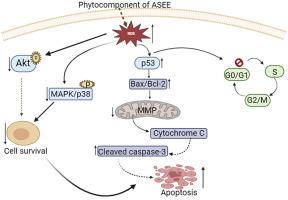Exploring the ROS-mediated anti-cancer potential in human triple-negative breast cancer by garlic bulb extract: A source of therapeutically active compounds
IF 3
3区 医学
Q1 INTEGRATIVE & COMPLEMENTARY MEDICINE
Journal of Traditional and Complementary Medicine
Pub Date : 2024-04-11
DOI:10.1016/j.jtcme.2024.04.003
引用次数: 0
Abstract
Background and aim
Allium sativum L. has been used medicinally and traditionally since antiquity. This study sought to examine the Allium sativum ethanolic extract (ASEE) in inducing apoptosis in human triple-negative breast cancer (TNBC) MDA-MB-231 cells and the molecular interactions of the identified components with cell death markers using in silico method.
Experimental procedure
Cytotoxicity of ASEE was tested on MCF-7, MDA-MB-231, and Normal Vero cells. The ROS production, apoptosis, MMP, and cell cycle study were conducted utilizing flow cytometer, and western blot was also performed for protein expression analysis. ASEE was phytochemically characterized by the HPLC while AutoDock Vina and iGEMDOCK tools investigated in-silico binding interactions.
Results
The HPLC method identified two active organosulfur chemicals, allicin and alliin, in ASEE. MTT test revealed significant (p < 0.05) inhibition of breast cancer cells proliferation. The inhibitory effect of ASEE was more pronounced in MDA-MB-231 cells than in MCF-7 cells, however, no substantial cytotoxicity was seen in normal Vero cells. TNBC cells treated with high concentrations of ASEE were found in the late apoptotic stage and exhibited an increase in ROS level and a reduction in MMP. ASEE exposure increased the percentage of cells in the G2/M phase. ASEE upregulated the p53 and Bax proteins while downregulated the Bcl-2, p-Akt, and p-p38 proteins. Allicin and alliin compounds had strong binding affinity with targeted proteins of breast cancer, and both compounds also showed good pharmacokinetics and druglikeness properties.
Conclusion
ASEE could be useful in the treatment of human triple-negative breast cancer without any safety risks.

探索大蒜球茎提取物介导的 ROS 在人类三阴性乳腺癌中的抗癌潜力:一种具有治疗活性的化合物来源
背景和目的薤白自古以来就有药用和传统用途。本研究试图利用硅学方法研究薤白乙醇提取物(ASEE)在诱导人类三阴性乳腺癌(TNBC)MDA-MB-231 细胞凋亡方面的作用,以及所发现的成分与细胞死亡标志物之间的分子相互作用。利用流式细胞仪对 ROS 生成、细胞凋亡、MMP 和细胞周期进行了研究,并对蛋白质表达进行了 Western 印迹分析。HPLC 方法鉴定了 ASEE 中的两种活性有机硫化学物质:大蒜素和大蒜素。MTT测试显示,ASEE对乳腺癌细胞的增殖有明显的抑制作用(p < 0.05)。ASEE 对 MDA-MB-231 细胞的抑制作用比对 MCF-7 细胞的抑制作用更明显,但对正常 Vero 细胞没有明显的细胞毒性。经高浓度 ASEE 处理的 TNBC 细胞处于凋亡晚期,ROS 水平升高,MMP 降低。ASEE 暴露增加了处于 G2/M 期的细胞百分比。ASEE 上调了 p53 和 Bax 蛋白,同时下调了 Bcl-2、p-Akt 和 p-p38 蛋白。大蒜素和大蒜素化合物与乳腺癌的靶向蛋白有很强的结合亲和力,这两种化合物还表现出良好的药代动力学和药物亲和性。
本文章由计算机程序翻译,如有差异,请以英文原文为准。
求助全文
约1分钟内获得全文
求助全文
来源期刊

Journal of Traditional and Complementary Medicine
Medicine-Complementary and Alternative Medicine
CiteScore
9.30
自引率
6.70%
发文量
78
审稿时长
66 days
期刊介绍:
eJTCM is committed to publish research providing the biological and clinical grounds for using Traditional and Complementary Medical treatments as well as studies that demonstrate the pathophysiological and molecular/biochemical bases supporting the effectiveness of such treatments. Review articles are by invitation only.
eJTCM is receiving an increasing amount of submission, and we need to adopt more stringent criteria to select the articles that can be considered for peer review. Note that eJTCM is striving to increase the quality and medical relevance of the publications.
 求助内容:
求助内容: 应助结果提醒方式:
应助结果提醒方式:


